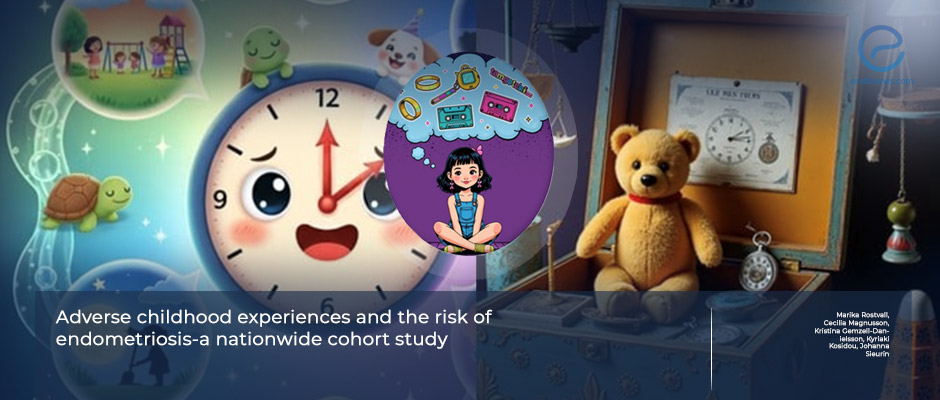From childhood trauma to adult disease: adversity tied to endometriosis diagnosis
Aug 22, 2025
Violence, instability, and family adversity linked to higher endometriosis risk, Swedish study shows.
Key Points
Importance:
- The etiology of endometriosis is multifactorial and not fully understood.
- Previous studies suggested an association between self-reported childhood abuse and endometriosis, but large-scale, register-based evidence has been lacking.
Highlights:
- Early life hardships may leave lasting imprints on women’s reproductive health, making childhood adversity a critical factor to consider in endometriosis care and prevention.
What's done here
- This is a nationwide prospective cohort study in Sweden, including all women born 1974–2001.
- Linked multiple national registers to identify childhood adversities and endometriosis diagnoses by ICD codes.
- Exclusions are women who died, emigrated, were adopted, or diagnosed with endometriosis before age 15.
- Final analytical sample comprised 1,316,946 women, of whom 24,311 had endometriosis.
- Univariate and multivariate Cox proportional hazards regression was used for statistical evaluation.
Key Results:
- Most adversities studied—parental psychiatric illness, substance abuse, intellectual disability, teenage parenthood, separation, residential instability, exposure to violence, receipt of public assistance, and child welfare intervention—were significantly linked to increased risk.
- Familial death was the only adversity not associated with endometriosis.
- A clear cumulative effect was found: one adversity increased risk by ~20%, while ≥5 adversities increased risk by ~60%.
- Associations persisted after adjustment for socioeconomic and demographic covariates.
- Childhood adversities were significantly associated with a higher risk of subsequent endometriosis.
- The strongest association was observed for exposure to violence.
- The weakest, but still significant, association was having a teenage parent.
- Risk increased in a dose-dependent manner: women with ≥5 adversities had up to a 60% higher risk of endometriosis.
Strengths and Limitations
- This is the largest study to date linking childhood adversity and endometriosis, based on nationwide longitudinal registers rather than self-report. Another strength is the presence of dose–response relationship that highlights the cumulative impact of adversity.
- Limitations are the underdiagnosis of endometriosis, so some cases may have been missed, potentially introducing bias. Also, the observational design cannot fully disentangle biological from social pathways.
From the Editor-in-Chief – EndoNews
"This nationwide Swedish study breaks new ground by linking early life adversities to endometriosis in adulthood. The dose-dependent increase in risk—up to 60% higher in women exposed to multiple adversities—underscores how profoundly childhood environments can shape later gynecologic health.
For researchers, the findings highlight the need to investigate biological mechanisms connecting psychosocial stress to disease, such as immune dysregulation, altered pain processing, and psychiatric comorbidity. For clinicians, they serve as a reminder to consider psychosocial history when evaluating women with pelvic pain, as those with adverse childhood experiences may represent a higher-risk group. For society, they reinforce the importance of policies that protect children and support families, since the consequences of adversity echo across decades.
The key message: childhood adversity is not only a social determinant of health but also a potential contributor to endometriosis risk. Recognizing this link can expand both our understanding and our approach to care."
Lay Summary
The causes of endometriosis remain incompletely understood, with multiple theories proposed, including retrograde menstruation, immune dysfunction, hormonal and environmental influences. More recently, evidence has suggested that adverse experiences in childhood may contribute to the risk of developing endometriosis later in life.
Rostvall and colleagues from Karolinska Institutet, Sweden, investigated this question in a large, nationwide cohort of more than 1.3 million women, born between 1974 and 2001. Using linked national registers, the researchers analyzed the relationship between a wide range of childhood adversities—including parental substance use, psychiatric illness, intellectual disability, teenage parenthood, separation, residential instability, exposure to violence, and child welfare intervention—and the subsequent diagnosis of endometriosis.
The study showed that almost all adversities were associated with a higher risk of endometriosis, with exposure to violence showing the strongest link.
Importantly, the risk increased in a dose-dependent manner: women exposed to five or more adversities faced up to a 60% higher risk of developing endometriosis compared to those without adverse experiences.
The authors suggest that the connection may be explained through immune dysregulation, pain sensitization, increased health-seeking behavior, or coexisting psychiatric conditions. They also acknowledge that socioeconomic and healthcare access differences may have influenced the associations observed.
This landmark Swedish register-based study, published in Human Reproduction, highlights the need for clinicians to recognize childhood adversity as a potential risk factor for endometriosis and to adopt a multidisciplinary approach when evaluating and supporting women with chronic pelvic pain or suspected disease.
Research Source: https://pubmed.ncbi.nlm.nih.gov/40495636/
child abuse childhood adversity childhood maltreatment parents dysmenorrhea epidemiology endometriosis.

